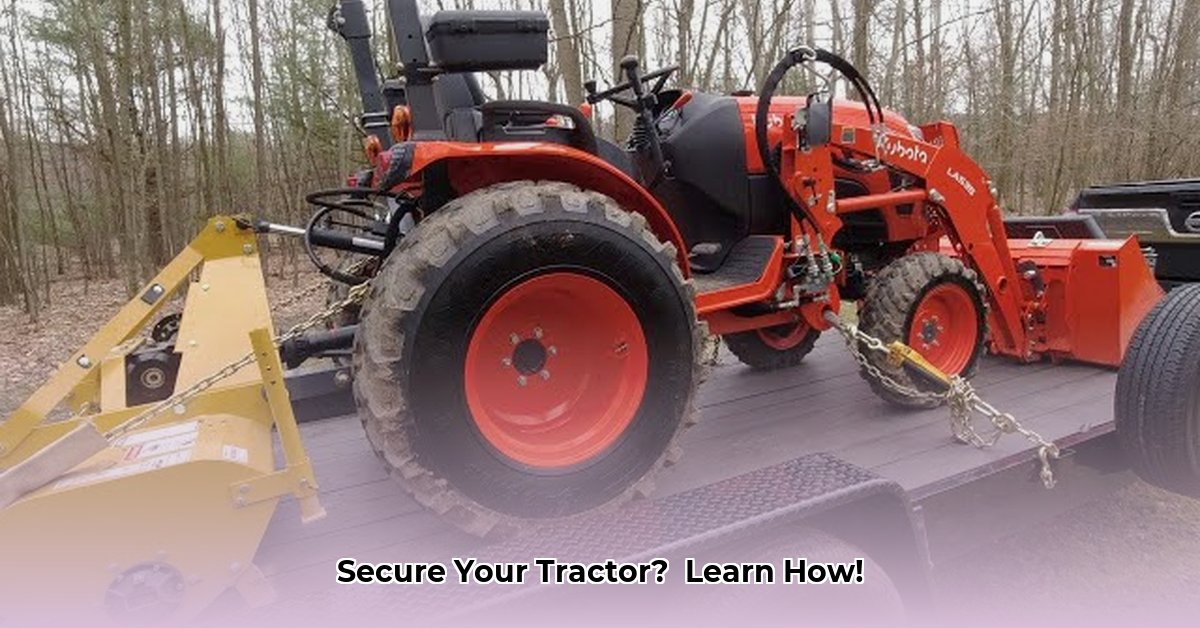
Moving a tractor requires careful planning and execution to ensure both the tractor and the operator's safety. Improperly securing a tractor can lead to damage and serious injury. This comprehensive guide provides a step-by-step process for safely transporting your tractor. For helpful weight charts, see this tractor weight guide.
Getting Ready: Assessing Your Equipment and Planning for Safe Transport
Before you begin, thorough preparation is crucial. This section outlines the essential steps to take before loading your tractor onto the trailer.
1. Determining Your Tractor's Weight: A Critical First Step
Accurately determine your tractor's weight, including any attachments (plow, loader, etc.), and fluids (fuel, oil). This weight is paramount in choosing the appropriate tie-downs and trailer. Using a certified scale is recommended for precise measurement. Guessing can be dangerous and lead to insufficient securing.
2. Selecting the Right Trailer: Size and Capacity Matter
Choose a trailer sufficiently large to accommodate your tractor and leave enough space for safe maneuvering. A minimum of 16 feet is generally recommended, but for larger tractors or those with attachments, a longer trailer (18-20 feet) provides better weight distribution and stability. The trailer's weight capacity must significantly exceed the total weight of your tractor and any attachments. Overloading is a major safety hazard. A 10,000 lb or greater capacity is generally recommended for larger tractors. "A larger trailer provides a significant safety margin," states John Deere expert, Sarah Miller, Agricultural Engineer at John Deere.
3. Identifying Secure Tie-Down Points: Strengthening Your Foundation
Locate strong points on both your tractor and trailer for attaching tie-downs. Typically, these are sturdy parts of the frame or axles. Always inspect these points for wear and tear before use. Compromised tie-down points must not be used, as this may lead to serious accidents while in transport.
Choosing the Right Tie-Downs: Strength and Security
Selecting the appropriate tie-downs is crucial for a secure transport. This section details the types of tie-downs available and their application for tractor securing.
1. Grade 70 Chains: The Reliable Workhorse
Grade 70 chains are a common choice due to their strength and durability. Always verify the chain's working load limit (often stamped on the chain) and ensure it significantly exceeds your tractor's weight.
2. Ratchet Straps: Versatility and Flexibility
Ratchet straps offer flexibility, particularly useful for securing smaller tractors or specific attachments. Ensure they are rated for the weight of the tractor.
3. Quantity and Redundancy: Better Safe Than Sorry
At minimum, you should use two tie-downs for tractors weighing under 10,000 pounds. Heavier tractors generally require four or more. Always err on the side of caution; additional tie-downs provide redundancy and enhanced security. "Using an excessive amount of tie-downs is never a bad idea in this scenario. It's all about safety and best practices", explains Mark Thompson, a veteran trucking safety expert.
Securing Your Tractor: A Step-by-Step Guide to Safe Transport
This section provides a detailed, step-by-step procedure for safely tying down a tractor on a trailer.
1. Tractor Preparation: Ensuring a Stable Start
Engage the parking brake firmly, shift the tractor into neutral, and disengage the Power Take-Off (PTO) (if equipped). This prevents accidental movement during loading and transport.
2. Loading the Tractor: Smooth and Controlled Movement
Carefully and slowly drive the tractor onto the trailer, ensuring it's centered. Avoid any sudden movements or abrupt stops.
3. Securing the Wheels: Preventing Roll-Away
Secure the wheels to the trailer using chains or straps. A crisscross pattern anchoring to the trailer's D-rings is highly recommended for maximum stability. This prevents wheel movement during transit.
4. Securing the Tractor Frame: A Critical Step in Safety
Tie down the tractor's frame to the trailer's frame using chains or straps. Again, prioritize a crisscross pattern for additional stability and weight distribution.
5. Securing Attachments: Extra Precautions for Added Components
Attachments like front-end loaders or backhoes require individual securing, potentially using additional chains and straps, along with wood blocks to prevent shifting. The securement method depends upon the weight of the attachment.
6. Final Inspection: Meticulous and Critical
Perform a thorough visual inspection of all tie-downs. Ensure they are snug, correctly positioned, and show no signs of weakness or damage. Tighten anything that appears loose or under tension.
7. The Wobble Test: Confirming Security
Gently rock the tractor to check for movement. Any detectable movement indicates insufficient tie-downs; adjustments must be made before proceeding.
8. Legal Compliance: Adhering to Transportation Regulations
Ensure your setup complies with all applicable local, state, and federal transportation regulations before driving. This is not optional; it's critical for safe practices.
Your Tractor Transport Checklist: A Summary of Essential Steps
This checklist helps ensure you haven't overlooked any crucial steps:
| Item | Checked? | Notes |
|---|---|---|
| Parking brake engaged | ||
| Tractor in neutral | ||
| PTO disengaged | ||
| Wheels secured | ||
| Frame secured | ||
| Moving parts secured | ||
| Chains/Straps properly tensioned | ||
| Visual inspection | ||
| Regulatory Compliance |
Remember, this guide provides general procedures. Always consult your tractor and trailer manuals for specific instructions and safety guidelines. When in doubt, seek professional assistance. Safe travels!